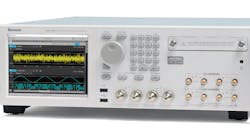AWGs Pack More Memory at Rates to 50 Gsamples/s
Signal generation has never been more complex, given the many types of analog and digital signals blended in modern communications and radar systems. To keep pace with generating realistic signals for testing these systems, Tektronix developed the AWG70000B Series arbitrary waveform generators (AWGs), which can be equipped with as much as 32-Gsample waveform memory to operate at waveform sampling rates to 50 Gsamples/s.
Of course, all that digital-to-analog-conversion (DAC) firepower would be inconsequential without the precision of 10-bit vertical DAC resolution using DACs capable of −80 dBc spurious-free dynamic range (SFDR). AWGs incorporate one or more high-speed DACs per channel to generate complex output waveforms when the DACs are fed digital representations of signals from stored waveform libraries.
The Tektronix AWG70000B Series features the single-channel model AWG70001B and the two-channel model AWG70002B AWGs (Fig. 1). The single-channel source can generate output waveforms to 20 GHz, while the dual-channel source provides two separate outputs, each as high as 10 GHz in frequency. The high-speed AWGs each include a dedicated Ethernet streaming ID connector on the rear panel with Streaming Waveform ID functionality for connection to a PC.
1. The AWG70000B Series arbitrary waveform generators (AWGs) include single-channel models capable of outputs to 20 GHz and dual-channel models with separate outputs each to 10 GHz.
By using these AWGs under control of the Microsoft Windows 10 operating system (OS), operators have access to 16,383 sequence steps in Tektronix’s AWG Waveform Library (Fig. 2). They can also generate complex waveforms by streaming instructions to each AWG via its dedicated Ethernet streaming ID connector, using combinations of the sequence steps. By selecting and combining different sequence steps, users can quickly create complex modulated communications signals, radar pulses, electronic warfare (EW), and electronic-countermeasures (ECM) waveforms, for almost instant modifications to even complex modulated waveforms. In addition, the software upgrade to the Windows 10 OS meets many corporate and government IT requirements.
2. Software control simplifies the generation of complex output waveforms with the AWG70000B Series AWGs.
Forging Waveforms
These AWG signal sources are suitable for a wide range of test applications, from commercial wireless communications systems and video systems to EW and military radar systems. They support the dynamic ranges needed to mimic real-world signal environments, with the ease of programming provided by the MS Windows 10 OS to create the most exotic and elaborate test waveforms.
The fast signal rise times of both AWGs (see table) makes them candidates for testing both defense-based and the rapidly emerging commercial radar systems helping to guide the growing number of vehicles equipped with advanced driver-assistance system (ADAS) electronic equipment. The single-channel model AWG70001B is capable of a signal rise time of 27 ps while the dual-channel model AWG70002B can generate pulses with rise times as fast as 22 ps/channel.
The speed and generous memory capacities of these AWGs support the dynamic signal-generation needs of defense-related applications, such as software-defined radios (SDRs). They also enable the synthesis of highly modulated waveforms, e.g., orthogonal-frequency-division-multiplex (OFDM) waveforms. By creating such advanced waveforms, it’s possible to realistically characterize the systems that use them. And by performing system-level measurements with such precise test signals, one can achieve high levels of transmission efficiency in both commercial and military communications systems where short transmission times must be relied upon to transfer a great deal of critical information.
The single-channel model AWG70001B can achieve maximum output frequency to 20 GHz while the AWG70002B offers two separate channels, each with maximum output frequency of 10 GHz. Both signal sources employ at least a pair of DACs with 10-b vertical resolution. Standard AWG70001B units are equipped with 2-Gsample waveform memory, with the option to extend the waveform memory to as much as 32 GSamples. Similarly, standard two-channel AWG70002B AWGs come with 2-Gsamples waveform memory and can be equipped with as much as 16-Gsample waveform memory per channel (for the same 32-Gsample total). Both the single-channel AWG70001B and the dual-channel AWG70002B achieve SFDR of −80 dBc and operate at 1-ksample/s to 50-Gsample/s rates to support a wide range of output waveform synthesis.
When multiple-input, multiple-output (MIMO) and truly advanced signal-generation formats are needed, as many as four of the AWG70001B and AWG70002B AWGs can be synchronized together for high-speed in-phase/quadrature (I/Q) signal generation and to test phased-array radar systems. By using an AWG sync hub alongside as many as four AWG70000B AWGs controlled with SourceXpress PC software, the phase of the output signals can be maintained within a single clock cycle and tightly controlled within a phase adjustment range of ±10.800 deg. Any skew issues of the multiple output signals can be controlled within a skew adjustment range of ±10 ps for the multiple AWGs.
For advanced signal generation, especially for pulsed and complex modulated waveforms, these AWGs provide the power of the latest high-resolution, high-speed DACs under the control of the most up-to-date PC software. Whether as a single source of test signals or as many as four AWGs tightly synchronized together within the fraction of a phase degree, these AWGs provide the precision and resolution needed for testing SDRs, phased-array radars, and other military electronic systems. And they have the versatility to handle most types of modulation used in commercial high-speed, high-frequency systems. P&A: $83,600 and up; stock.
Tektronix Inc., 14200 SW Karl Braun Dr., Beaverton, OR 97005; (503) 627-7111.




